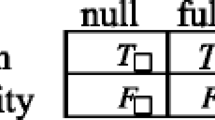Abstract
I provide a truthmaker semantics for Angell’s system of analytic implication and establish completeness.
Similar content being viewed by others
Notes
I should like to thank a number of people for helpful discussion of the topic of this paper. They include the participants at a seminar at NYU and the audiences at talks which I gave at the New York Philosophical Logic Group and at a workshop of the Mathematical Philosophical Group in Munich. I have also greatly benefitted from the writings of Fabrice Correia, Lloyd Humberstone, and Steve Yablo.
Branden Fitelson has used a computer program to show that these axioms and rules are indeed independent of one another.
Models with a component R for ‘reality’ are also considered in Fine [8].
References
Angell, R.B. (1977). Three Systems of First Degree Entailment. Journal of Symbolic Logic, 47, 147.
Angell, R.B. (1989). Deducibility, Entailment and Analytic Containment’, chapter 8 of Norma and Sylvan [14], pp. 119–144.
Angell, R.B. (2002). A-Logic: University Press of America.
Brink, C. (1986). Power Structures and Logic. Quaestiones Mathematicae, 9 (1–4), 69–94.
Correia, F (2004). Semantics for Analytic Containment. Studia Logica, 77, 87–104.
Ferguson, T. (2015). Faulty Belnap Computers and Subsystems of FDE’, to appear in the Journal of Logic and Computation.
Fine, K. (1985). Reasoning with Arbitrary Objects. Oxford: Blackwell.
Fine, K. (2014). Truthmaker Semantics for Intuitionistic Logic. Journal of Philosophical Logic, 43.2, 549–77. reprinted in Philosophers’ Annual for 2014.
Fine, K. (2014). Constructing the Impossible’, to appear in a volume for Dorothy Eddgington.
Gardenfors, P. (2004). Conceptual Space, (p. 2004). Bradford: Bradford Books.
Gemes, K. (1997). A New Theory of Content II: Model Theory and Some Alternatives. Journal of Philosophical Logic, 26, 449–476.
Humberstone, L. (2003). False though Partly True - An Experiment in Logic. Journal of Philosophical Logic, 32(6), 613–665.
Lewis, D. (1988). Statements Partly About Observation. In Papers in Philosophical Logic: Cambridge University Press.
Norma, J., & Sylvan, R. (Eds.) (1989). Directions in Relevant Logic. Dordrecht: Kluwer.
Parry, W.T. (1933). Ein Axiomensystem fur eine neue Art von Implikation (Analytische Implikation), Ergebnisse eines Mathematischen Kolloquiums 4, pp. 5–6.
Van Fraassen, B. (1969). Facts and Tautological Entailments. Journal of Philosophy, 66, 477–87.
Yablo, S. (2014). Aboutness. Princeton: Princeton University Press.
Author information
Authors and Affiliations
Corresponding author
Rights and permissions
About this article
Cite this article
Fine, K. Angellic Content. J Philos Logic 45, 199–226 (2016). https://doi.org/10.1007/s10992-015-9371-9
Received:
Accepted:
Published:
Issue Date:
DOI: https://doi.org/10.1007/s10992-015-9371-9




